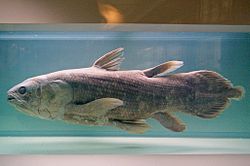Latimeria
|
Latimeria Temporal range: Holocene, 0 Ma |
|
|---|---|
 |
|
| West Indian Ocean coelacanth (Latimeria chalumnae), Natural History Museum of Nantes | |
| Scientific classification | |
| Kingdom: | Animalia |
| Phylum: | Chordata |
| Class: | Sarcopterygii |
| Order: | Coelacanthiformes |
| Family: | Latimeriidae |
| Genus: |
Latimeria J. L. B. Smith, 1939 |
| Species | |
 |
|
| Range in red and violet | |
Latimeria is a rare genus of fish that includes two extant species: West Indian Ocean coelacanth (Latimeria chalumnae) and the Indonesian coelacanth (Latimeria menadoensis). They follow the oldest known living lineage of Sarcopterygii (lobe-finned fish and tetrapods), which means they are more closely related to lungfish, reptiles and mammals than to the common ray-finned fishes. They are found along the coastlines of the Indian Ocean and Indonesia. Since there are only two species of coelacanth and both are threatened, it is the most endangered genus of animals in the world. The West Indian Ocean coelacanth is a critically endangered species.
Based on growth rings in their ear bones (otoliths), scientists infer that individual coelacanths may live as long as 80 to 100 years. Coelacanths live as deep as 700 m (2300 ft) below sea level, but are more commonly found at depths of 90 to 200 m. Living examples of Latimeria chalumnae have a deep blue color which probably camouflages them from prey species; however, the Indonesian species (L. menadoensis) is brown.
Coelacanth eyes are very sensitive, and have a tapetum lucidum. Coelacanths are almost never caught in the daytime, but have been caught at all phases of the moon. Coelacanth eyes have many rods, receptors in the retina that help animals see in dim light. Together, the rods and tapetum help the fish see better in dark water.
...
Wikipedia
